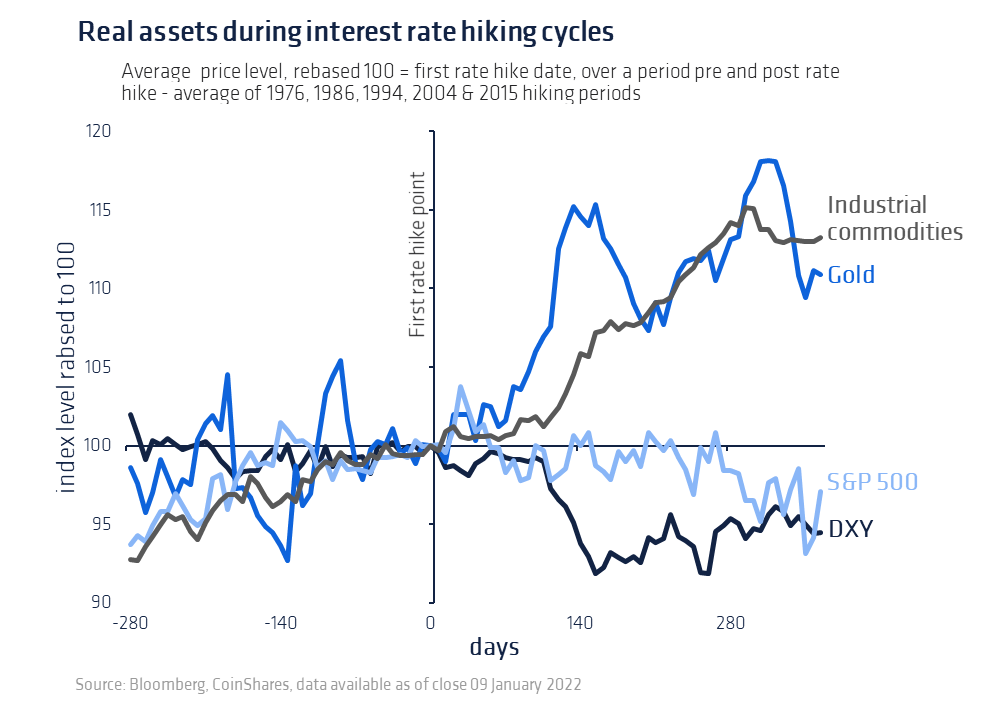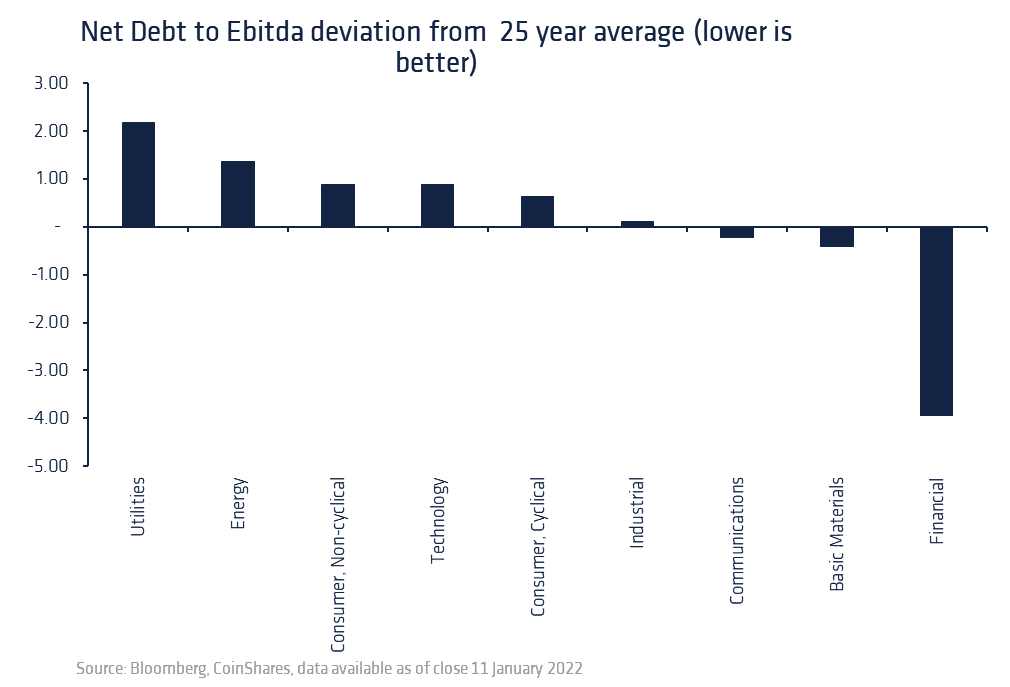Cryptocurrencies have sold off alongside risk assets, on fears of interest rate hikes. But how serious is the threat to cryptos, and more particularly to Bitcoin?
Investors have spent the last 10 years, following unprecedented levels of quantitative easing (QE), expecting to see inflation kick-in, only for it not to happen. Perhaps one of the most plausible explanations is that the transmission mechanisms haven’t worked as expected, with QE often being used in an unproductive way, where companies have taken advantage of low bond yields for stock buybacks rather than growth initiatives. It has taken a world health crisis (COVID) to expose the threadbare global logistics network, highlighting significant supply bottlenecks that have helped push up inflation to levels not seen in the US since June 1982.
Bitcoin’s sensitivity to Fed actions
We have seen in the most recent FOMC minutes that the US Federal Reserve is increasingly worried about inflation, prompting them to end QE tapering in March while considering 4 interest rate hikes in 2022 rather than the consensus of only 2 around six months ago.
What will happen to Bitcoin in a rising rate environment? Bitcoin rose by 51% 6 months after the first rate hike in 2015, but we believe Bitcoin has matured significantly since then and is therefore likely to behave differently, and likely in line with other real (inflationary) assets. Therefore, analysis of how other real assets have behaved in previous rate hike cycles are likely to give us some idea as to how Bitcoin may behave.
The anatomy of rate hikes
While every historical hiking cycle is different, similarities exist. To best represent today’s scenario, we have identified five out of the potential nine periods post-Bretton Woods tightening cycles. The periods in December 1976, December 1986, February 1994 and June 2004 and 2015 are closest to today in that they represent periods where rates were either falling or relatively low for a long period of time beforehand. We are encouraged by the fact that the analysis highlights surprising consistency in each of the five periods observed.

Gold and Industrial commodities tend to appreciate during rate hikes
Gold is an example where performance hasn’t been consistent: in 1976, 1986 and 2004 prices rose 22%, 25% and 11% respectively, whilst in 1994 prices fell by 2.6% one year after the first hike. Inflation was the likely culprit for the rises in 1976 and 1986 but not in 2004, where inflation was better controlled. A key differentiator in 1994 was that real interest rates rose by 3%, whilst in the other periods, it remained flat or negative, confirming that rising real interest rates tend to be negative for gold. Industrial commodities, another real asset, tend to behave in a similar way during rate-hiking cycles. The S&P500 is technically a real asset and tends to initially rally, but then begins to sell off, likely due to tightening credit conditions biting into corporate profitability.
USD usually sells off, contrary to popular belief
The dollar tends to remain flat prior to rate hikes, or rise, but then in every case has been volatile and fallen by an average of 7% within a year. This fact may be counter intuitive as the constriction of money supply leads to fewer dollars in circulation. We believe the most likely explanation for this is that markets tend to fully price the prospect of a stronger economy and improving the jobs market before the event occurs. It looks like USD is behaving in a similar way, since November 2021 the dollar has been strengthening against a broad set of currencies, while Bitcoin, which trades inversely to the USD has been selling off.
The Fed is behind the curve – increasing the risk of a policy error
Monetary policy should be proactive and as inflation is a lagging indicator of the state of the economy, it could be argued that the Fed is already behind the curve. It must be kept in mind that monetary policy also has a lagged impact on the economy of between 1-2 years so the interest rate hikes starting today are unlikely to have an immediate impact.
The liquidity created by QE and exceptionally low interest rates has caused a high-risk conundrum for the Fed. As QE is progressively removed and interest rates begin to rise, it increases the risk of a disorderly correction in equity and bond markets that have become so reliant on stimulus. On the one hand the Fed has a mandate to control inflation, but it also has a mandate of stable prices, it is therefore very challenging to see how the Fed can control both at present.
The firepower (the amount interest rates can be raised) of the Fed must also be taken into consideration and on the face of it, household debt service ratios look healthy, with an average of 9.1% of household debt being spent on servicing debt, the lowest point since records began. Corporations appear healthy too, with net debt to EBITDA at 1.3 years versus the long-term average of 1.7 years. This suggests that the Fed has substantial room to raise interest rates before it begins to stress the economy.

Although there are some sectors of the economy where net debt to EBITDA do not look so healthy, particularly utilities, energy and healthcare, which are in a worse position now than just prior to the 2008 financial crisis. While technology net debt to EBITDA is at its highest since 1998, it is still low relative to other sectors. One of the unintended consequences of raising interest rates too aggressively could be a rise in defaults and unemployment in these crucial sectors of the economy, causing social unrest and greater political instability.
Real assets are likely to benefit
We believe Bitcoin is likely to behave in a similar way to gold and other real assets, being priced in US dollars and being of fixed supply. We have already seen in December 2021 and January 2022 that Bitcoin is extremely sensitive to the threat of interest rate hikes, having sold off by almost 42% from its highs in what we believe is a reaction to inflation and the increasing probability of a greater number of rate hikes in 2022. In the longer term, we see there being a high risk of a Fed policy error (waiting too long and then raising interest rates too aggressively), with the US dollar then selling off, both of which are likely to be supportive of Bitcoin and other real assets.




